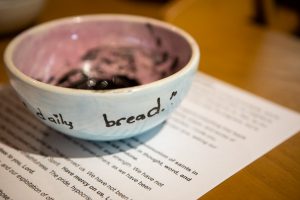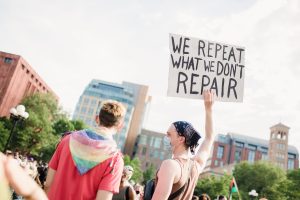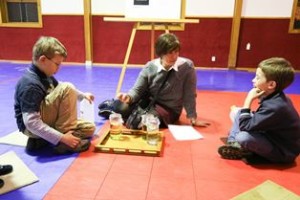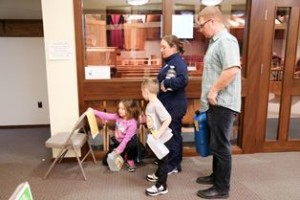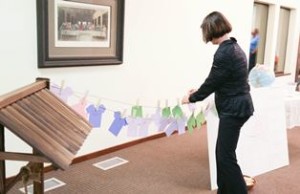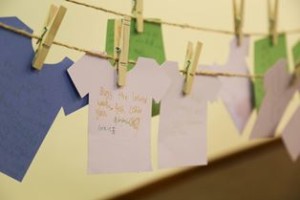Investment
“[The vision is] that we get to invest money in our families and in our community.”
The first reading for this fourth week of Lent is from the book of Numbers. The people have been on their exodus from Egypt to the Promised Land for years, and the goal is nigh. They have received the law from God through Moses at Sinai and are now on the final leg of their journey. Yet, rather than be hopeful and eager, they are tempted by impatience (Numbers 21:4) and dissatisfied with the leadership of Moses and even their “miserable food” (Numbers 21:5). The exodus they thought would bring them to a new land has instead been a seemingly interminable journey in the wilderness. God’s response is swift and harsh: “poisonous serpents” sent by God “bit the people, so that many Israelites died” (21:6). The people repent, Moses prays andGod grants Moses a staff that will provide healing to all who are bitten.
It’s not the kindest of stories. The psalmist gives it a different sort of spin, omitting any mention of the venomous snakes and lifting up the healing of God, who heard the cries of the people and “saved them from their distress” (Psalm 107:19b).
Despite the psalmist’s sanitized take on the story, this pattern can be found throughout the story of the exodus. God rescues the people, they succumb to temptation, they repent, God shows mercy. Over and over and over.
These biblical narratives are often used to extol the merciful nature of God, who repeatedly forgives the people despite their sin. Truly, God does show mercy. But perhaps mercy is not the only lesson to be learned from the story of the people’s walk with God.
The exodus begins in Egypt, where God’s people are enslaved and oppressed. God seeks out Moses to lead the people, lays low the unjust Pharaoh and accompanies the people across the wilderness for generations, providing food, water and safety along the way, even when the going is tough and the relationship between the people and God is complicated.
Simply put, God is invested in this community. God has a vested interest in its future. The covenant inaugurated between them leaves both parties vulnerable to the other. By leading them from Egypt and entering into a covenant with them, God has tied their futures together. God has a plan and has invested much to ensure that the people are part of it. This people, this nation, is God’s future. The provisions God grants are not mere merciful gifts but further investments toward a shared future for God and the people that will become Israel.
Now, of course, the church is not God; we are spiritual descendants of the wandering Hebrews, dependent still on God’s promise of this future. Yet, perhaps there is something we can learn here about what it means to pursue a promise.
People often view the church’s work to end hunger in light of the virtues of mercy and grace. Food, clothing, shelter and donations might be interpreted as mercies showered on suffering people or as gifts given to neighbors in need. But the reality is that our response to hunger goes beyond a desire to meet immediate needs. Our response to hunger is nothing less than an investment in that shared future articulated in the tagline for ELCA World Hunger: a just world where all are fed.
What difference might it make for the hunger ministries of this church to see the work we do together as an investment in this vision?
In Washington, D.C., the Beloved Community Incubator is based on the idea of investing in the people and in the Logan Circle neighborhood. The project began with a listening campaign by Luther Place Memorial Church, with support from ELCA World Hunger. In this campaign, residents of the community expressed their desire for cooperatives that would allow them to use their skills and talents to build wealth and income that would stay in the community.
The first cooperative incubated by Luther Place was Dulce Hogar, a cooperative of women who provide cleaning services for homes and businesses. Together, the women learned how to run a business, pursue just employment and develop their own skills as leaders. As one participant describes it, “The vision of the cooperative is that all eight of us are well-paid and well-trained, and that we get to invest money in our families and in our community.”
The members of the cooperative were even paid for the times they spent in meetings and trainings. They learned together that their time and labor had value far exceeding the wages they had been offered before. And now, with an investment in them, they will be able to invest in others.
Projects such as the Beloved Community Incubator offer a counter witness to the policies and practices of disinvestment that have created communities with high rates of poverty and food insecurity across the United States. These policies and practices are rooted in the misperception that some communities are worth investing in and others are not. But the residents of Logan Circle know that, despite the challenges they face, their community is worth the investment and a better future is worth pursuing.
We know this, too, by faith. Every community is blessed by God with assets and strengths, even as the people face barriers to using or developing those assets. And we know by faith that the future we pursue together is a shared endeavor. The future God has promised is a future for us and our neighbors. We will get there together, or we will not get there at all.
To end hunger is to recognize that responding to need is a matter not of merciful intervention but of investing in a shared future and trusting that the work of God toward that end will be revealed in those very communities that the profit-driven economy so often leaves behind. If we are going to end hunger, we need to invest in one another by sharing resources, listening to each other and building the relationships that will ensure the justice God has promised.
Discussion Questions
- Think, share or journal about a time when someone showed you kindness and mercy. What was that like? How did it feel?
- Think, share or journal about a time when someone used their time, skills and/or talents to invest in your growth. What was that like? How did it feel?
- Now compare and contrast these two experiences — one of kindness and mercy, and one of investment. How are they different? Which experience made a more lasting impact, and why?
- Does your community take time to invest in the long-term growth of its neighbors? How so? If not, how might your community begin investing in others? What might that look like?
- Where is there a need for the kind of investment that can end hunger in your community?
Prayer
Covenant God, since ancient times you have led and fed your people through many wilderness journeys. In this time, give us strength to invest your gifts in our neighbors and communities, that all might be fed. Amen.
Learn more and follow ELCA World Hunger’s 40 Days of giving throughout Lent by visiting ELCA.org/40days.



